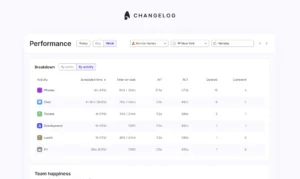
Split shifts: How to improve flexibility for support teams

A split shift refers to a work schedule involving two or more shifts that are separated by a break. They are increasingly popular for remote teams, specifically in customer support, as they allow companies to offer their team more flexibility to accommodate personal commitments whilst having their team online at peak hours.
Split shifts are also a useful way for customer support teams to offer extended hour coverage to their customers so they can get in touch on weekends or during the evening. By enabling agents (or surfers as we call them) to take a break for a few hours during the day, they can recommence their working hours after fulfilling other commitments and when phone lines or chat queues get busy again.
Split shifts are great for boosting morale but for also managing costs effectively. They can be a win-win for teams that want to make sure their surfers are online when customers need them, avoiding downtime but also offering their team the flexibility to work hours that suit them.
Benefits of Split Shifts in Customer Support
Increased coverage
Split shifts allow customer support teams to provide coverage over a longer period of time and schedule their team to work when their customers need them to be online. A company effectively using split shifts has the ability to schedule their team to cover their peaks, balancing coverage whilst ensuring surfers work their contracted hours.
Lower costs
Split shifts can help reduce headcount requirements. By enabling teams to schedule according to peaks and split the day accordingly, less people are needed than in a traditional model that includes downtime.
Flexibility
Split shifts offer more flexibility for surfers, allowing them to work at different times of the day and fit work around their personal commitments. This leads to increased job satisfaction and a better work-life balance.
A happier team is very positive for the support function as performance improves and turnover rates drop. Importantly, happy teams lead to happy customers, and providing positive customer experiences is the ultimate goal of the support function.
Data from the Shift Project also suggests offering shift flexibility in forms such as shift splits improves diversity and inclusion initiatives. Schedule instability disproportionately impacts women and ethnic minorities. Improving work-life balance is critical in facilitating racial, ethnic and gender equality in scheduling.
No more burnout
By breaking up the workday into smaller chunks, surfers are less likely to experience burnout or fatigue from working long hours. Enabling surfers to work split shifts allows them to be human. They can go on the school run, care for a family member, meet a friend, or just take a break. This undoubtedly leads to closer ties within a support team, and the knock-on effect of allowing a team to be human is that they treat customers like humans as a result.
Split shifts further the case for flexible working and promoting work-life balance, which is equally valuable for turnover. When teams are well-rested and living a life that’s driven by their personal needs rather than their shift schedule, they’re happy. Happy teams enjoy lower turnover rates, which is good for customers too. High turnover results in lower productivity and higher costs in hiring and onboarding to backfill for employee churn.
How Surfboard removes the drawbacks of split shifts for a support team
Scheduling
One of the biggest challenges of split shifts is organising the shifts into a schedule. It can be difficult to ensure that surfers are available when they’re needed, and that there’s enough coverage during busy periods. This can require careful planning and communication to ensure that shifts are managed effectively. Often what support managers will find out is that scheduling normal shifts is chaotic enough. Now add split shifts into the equation and it’s almost impossible to manage.
That’s why Surfboard is the only platform that handles split shift scheduling specifically for customer support teams. We want you to be able to benefit from improved flexibility, better service levels, and less burnout, which is why we’ve built software to make it easy for you to schedule.
Training and Support
Split shifts can sometimes make it more difficult to provide consistent training and support for surfers. With different surfers working at different times, it can be harder to ensure that everyone is up to date on the latest procedures.
In support teams, no one day is the same as the next. A new challenge or opportunity comes up almost every day. Within their shift, a surfer might end up doing multiple different tasks. Between phones, email, live chat, social media channels and much more, surfers are kept busy. These tasks can also be referred to as intraday activities.
With the right software in place, teams can be as granular as they want with the different intraday activities a surfer will work on. That includes adding time for training, coaching sessions, and all-round development.
Communication
Split shifts can potentially lead to communication challenges, as surfers may be working at different times and not always available to collaborate with each other. This can make it more difficult to provide consistent support and may require additional tools and technology to facilitate communication and collaboration.
Support teams need somewhere to feel ‘connected’ with the rest of their team. With the shift towards a remote or hybrid style of work, the communication and collaboration aspect of working together as a team physically can be hampered. Collaborative software like Slack allows teams to stay in touch with one another.
The important point here is that teams should feel connected at all times. Using a team planning tool allows surfers to talk to each other, see what everyone is working on, and communicate with their team leads.
With Surfboard, surfers have visibility over the rest of their team with team view, and can communicate with their colleagues using Slack.
Tips for Managing Split Shifts in Customer Support
Plan ahead
To ensure that split shifts are managed effectively, it’s important to plan ahead and ensure that there is enough coverage during busy periods. This may require adjusting schedules or adding additional resources to ensure that customers are able to receive the support they need.
Most support teams will use some form of forecasting to predict the inbound demand they are going to receive. Ticketing systems like Dixa or Intercom will enable teams to predict the level of demand each of their channels will receive at any point. This is crucial when forecasting. Support teams can use Surfboards advanced forecasting to predict how many surfers they need on which channels at any one time.
Use scheduling software
To facilitate communication and collaboration between surfers, it’s important to use technology that allows teams to stay connected and share information. This may include messaging tools like Slack, ticketing software like Dixa, automation tools like Intercom, or a team planning tool like Surfboard. In combination, all of these tools help surfers work together effectively even when they’re working on different shift patterns.
To find out more about how Surfboard empowers teams to use split shifts and other ways of working flexibly, fill in your email below to schedule a demo.



